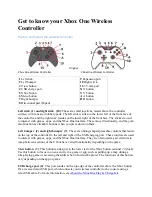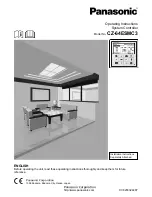
Lighting Control
Software Overview
•
5
-
7
are only using one Input Source for this equation,
leave the Logic 1 field blank.
•
Input 2
- Choose the type of input value that is used
as the second value in the logical equation. Choose
Logic, Sched, Llev, or Solar.
•
Logic 2
- Chooses the method of combining the
result of the Input 1 and Input 2 combination with
Input Source 3 (AND or OR). If you are only using
two Input Sources for this equation, leave the Logic
2 field blank.
•
Input 3
- Chooses the type of input value that will
be used as the third value in the logical equation.
Choose Logic, Sched, Llev, or Solar.
•
Logic 3
- Chooses the method of combining the
result of the Input 1, 2, and 3 combination with
Input Source 4 (AND or OR). If you are only using
three Input Sources for this equation, leave the
Logic 3 field blank.
•
Input 4
- Chooses the type of input value that is
used as the fourth value in the logical equation.
Choose Logic, Sched, Llev, or Solar.
5.4.2
Light Level Sensor
Verification
If Light Level and Solar are used together Light Level
sensor checking is enabled if light level proof is enabled.
If the Light Level Sensor and Solar Calculation do not
match for a user-specified time delay, an alarm is
generated. This alarm is submitted to the alarm subsystem.
The text of the alarm is “Light Level Sensor - Possible
Failure”.
5.4.3
Solar Calculation
The Sundown input tells the Lighting Control applica-
tion when sundown begins and ends (ON when sunset
occurs, and OFF at sunrise). It is automatically tied to the
SUNDOWN output of the Time and Date cell, and should
not be redefined if you plan on using solar calculations for
this Lighting Control application.
To set up the solar cell calculation (sunrise/sundown),
this can be configured in the Global Data application.
In Global Data, the Lighting application automatically
receives the information when the sun sets.
5.4.4
Digital Lighting Output
The application supports a digital lighting output. The
state of this output is determined based on the outcome of
the lighting control method that is selected.
5.4.5
Light Proofing
Light output proofing is supported by the application.
The following parameters are provided by the
application to configure proofing:
•
Proof Type
- Determines what light state(s) the
application will use proof checking for in the Proof
Type field.
There are three options:
-
ALL Values
- Proof checking verifies the lights
come ON when called to be ON and OFF when
called to be OFF.
-
ON Values
- Proof checking verifies only that the
lights have turned ON when called to be ON.
-
OFF Values
- Proof checking verifies only that the
lights have turned OFF when called to be OFF.
•
PROOF IN
- Proof input.
•
Proof Delay
- When the Lighting Control
application detects a proof failure, it waits for the
Proof Delay time period to pass before turning on
the Proof Status output. If during this delay the
proof input returns to normal, the delay is canceled
and the Proof Status output remains OK.
•
Proof Latch
- Once the Proof logic has recorded a
proof failure and the Proof Status output has
transitioned to FAIL, the output remains in FAIL
until the control input has been equal to the proof
input for an amount of time equal to the Proof Latch
delay. If during this delay the proof fails again, the
delay is canceled and the output remains in FAIL.
•
Clear Any Match
- Enter YES to clear the proof on
any match. If a proof failure should be cleared
whenever a match of any kind is made between the
proof input and the light state, set this to 'Yes.' If the
proof failure is to be cleared only when a match of
the type listed in the Proof Type field is made, set
this to “No.”
5.4.6
Minimum On/Off Times
The application supports minimum on and off times
for the digital lighting output.
The following user parameters are provided to
configure the minimum on/off times and the on/off delays
for the lighting output.
•
Min ON Time
- The least amount of time the
command value must remain ON before the Min
On/Off logic allows a transition to OFF. If the
command value has not been ON for at least this
value, the Min On/Off logic replaces the command
value with an ON signal until the Minimum ON
Содержание Site Supervisor
Страница 1: ...026 1800 Rev 3 02 AUG 2016 Site Supervisor Controller User Guide 2 0 ...
Страница 2: ......
Страница 13: ...Wiring Diagrams Hardware Overview 1 3 Figure 1 3 Site Supervisor 2 0 Detail ...
Страница 29: ...Wiring Examples 3 1 3 Wiring Examples Figure 3 1 Site Supervisor and MultiFlex Wiring ...
Страница 31: ...Wiring Examples 3 3 Figure 3 3 Site Supervisor and XR35CX 230V Wiring ...
Страница 33: ...Wiring Examples 3 5 Figure 3 5 Site Supervisor and XR75CX Wiring ...
Страница 35: ...Wiring Examples 3 7 Figure 3 7 Site Supervisor and XM678 Wiring ...
Страница 37: ...Wiring Examples 3 9 Figure 3 9 Site Supervisor and XEV22 Wiring ...
Страница 39: ...Wiring Examples 3 11 Figure 3 11 Site Supervisor and XEV32 Wiring ...
Страница 41: ...Wiring Examples 3 13 Figure 3 13 Site Supervisor and Thermostat Wiring ...
Страница 43: ...Wiring Examples 3 15 Figure 3 14 Site Supervisor and iPro S Wiring ...
Страница 121: ......
Страница 129: ......
Страница 135: ......
Страница 139: ......
Страница 140: ......
















































